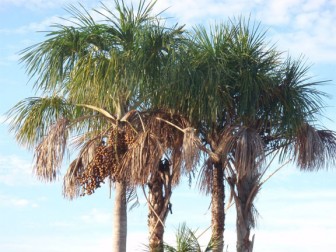Ite (Mauritiaflexuosa) also known as Morichi, belongs to the plant family which includes all palms (Arecaceae). It can be found throughout northern South America, especially in the Amazon region which includes Colombia, Venezuela, Peru, Bolivia, Ecuador and the Guianas. It occurs mainly in permanently swampy areas and gallery forests along rivers and savannas. In Guyana, Ite is abundant over large areas of the North-West Region along the coast and in the interior savannas of the North and South Rupununi.
The stem of this palm is smooth and straight and can reach a height of 25 m with diameters of 30-60 cm! It can be identified by its fan-shaped leaves and inflorescences (flowering branches) which hangs almost 2 m in length. The fruits which develop on the same branches that initially hold the flowers are covered with scales, brown-reddish in colour and are variable in shape but mostly ellipsoid (not perfectly round). If you see fruiting Ite palms it’s most likely the dry season in that region.
The Ite palm has a wide variety of market and household uses. The fibre from the leaves, locally called tibisiri can be used to make hammocks, thatch, furniture, baskets and carpets. Fresh leaves are used to make baskets and warishis (back packs) and the shoots of the leaves are

harvested and used as thatch for roofing. The hollowed out stem can be used to make canoes or split to make planks. The pith (centre) of the stem is the source of an edible starch similar to sago. The soft flesh of the fruits can be eaten or made into a drink, and in Peru and Brazil the sale of the fruits is economically important to rural villages. The pulp of the fruit is also used to make juice and icicles; dried, it produces a kind of flour which is very nutritious and forms an important part in the diet of many indigenous tribes. Old Ite trees which have fallen to the ground are also very important to indigenous people because of a beetle larva (Rhynchophoruspalmarum) or “Tacoma Worm” that feeds on the dead palm. These beetles are full of fat and tasty!
In addition to its high value to local people, it is also ecologically important as the fruits are eaten by many animals including Wild Hogs, Agouties, Laba, various birds, turtles, fish and wild cows (Tapirs).
Rain forests are rich in biodiversity and are home to many different plants and animals. In addition, indigenous communities make their homes there. Even if you don’t live in the rain forest, humans rely on the forest for resources such as building materials (wood and lianas), medicine and fruits. Rain forests also provide essential environmental services for life on earth; they create soil as well as prevent soil erosion, produce oxygen though photosynthesis, maintain clean water systems, and are a key defence against climate change.
The Iwokrama Rain Forest is 371,000 hectares, located in the heart of Guyana. Our mission is to develop strategies for conservation and sustainable development for local people in Guyana and the world at large. We are involved in tourism, training, research and our timber is certified by the Forest Stewardship Council. Come and visit us in the rain forest or at http://www.iwokrama.org.





